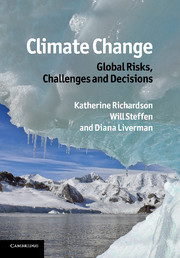Book contents
- Frontmatter
- Contents
- Writing team
- Foreword
- Preface
- List of acronyms and abbreviations
- Part I Climatic trends
- Part II Defining ‘dangerous climate change’
- Part III Equity issues
- Part IV Mitigation and adaptation approaches
- 11 Low-carbon energy technologies as mitigation approaches
- 12 Economic approaches and instruments
- 13 Geopolitics and governance
- 14 Adapting to the unavoidable
- Part V Meeting the challenge
- Index
- Plate section
- References
13 - Geopolitics and governance
Published online by Cambridge University Press: 04 April 2011
- Frontmatter
- Contents
- Writing team
- Foreword
- Preface
- List of acronyms and abbreviations
- Part I Climatic trends
- Part II Defining ‘dangerous climate change’
- Part III Equity issues
- Part IV Mitigation and adaptation approaches
- 11 Low-carbon energy technologies as mitigation approaches
- 12 Economic approaches and instruments
- 13 Geopolitics and governance
- 14 Adapting to the unavoidable
- Part V Meeting the challenge
- Index
- Plate section
- References
Summary
‘It's also why the world must come together to confront climate change. There is little scientific dispute that if we do nothing, we will face more drought, more famine, more mass displacement – all of which will fuel more conflict for decades. For this reason, it is not merely scientists and environmental activists who call for swift and forceful action – it's military leaders in my own country and others who understand our common security hangs in the balance.’
Politicians have observed regularly in recent years that climate change first emerged as an ‘environmental’ issue, which later became reconceptualised as an ‘economic’ issue, and is now perceived as a ‘security’ issue. What exactly this means is not always clear – notably whether it means that climate change can cause violent conflicts or that climate change as such is the biggest threat humankind faces (Section 13.6; Wæver, 2009a). Nevertheless, this transformation in the perception of climate change carries with it the unmistakable message that the importance of climate change has moved up some kind of ladder of politicisation. Climate change is not a technical issue, but a political one – and it belongs to the category of ‘high politics’ (Hoffmann, 1966) in that it affects the survival of the state (as opposed to ‘low politics’, which deal with more mundane or practical issues).
- Type
- Chapter
- Information
- Climate Change: Global Risks, Challenges and Decisions , pp. 344 - 387Publisher: Cambridge University PressPrint publication year: 2011
References
- 1
- Cited by

